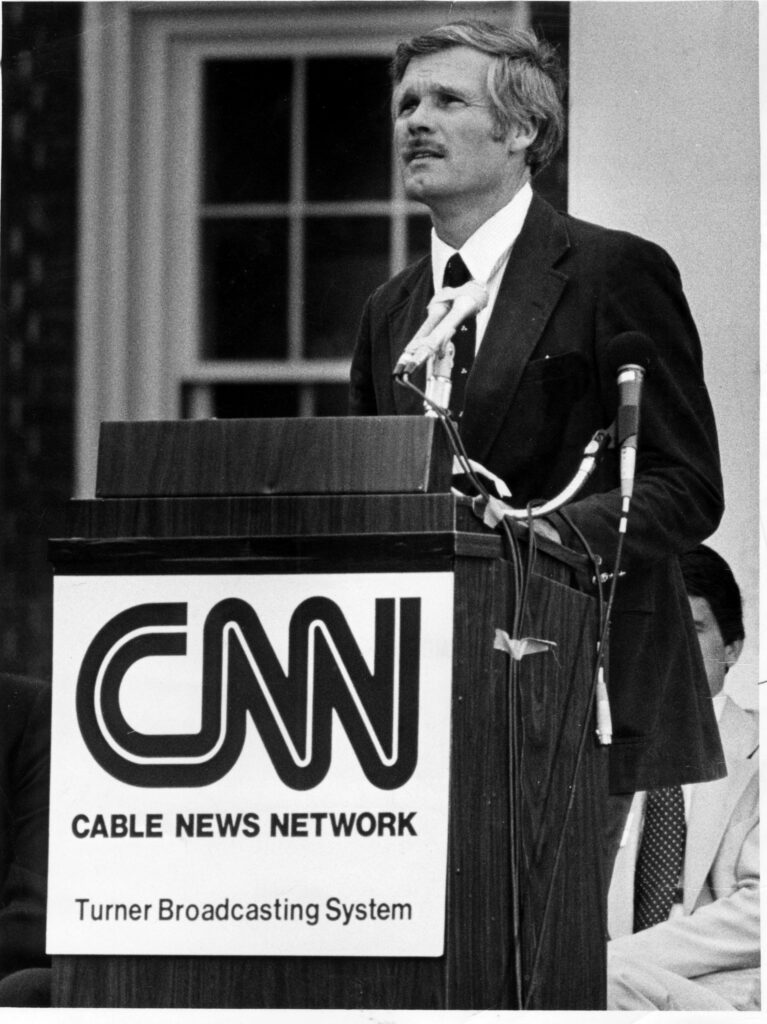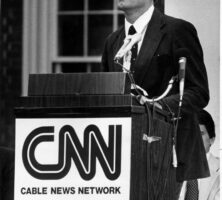Cable News Network (CNN) was the world’s first twenty-four-hour cable television news channel when it was established in 1980. From its home in Atlanta, CNN has extended its reach around the world, becoming a dominant force in national and international journalism. Along with its subsidiary channels and the competitors it helped inspire, the network has changed the way information flows throughout an increasingly connected world.
Origins
CNN was founded by Georgia businessman Ted Turner. In the 1970s Turner took advantage of the increasing availability of communications satellites to begin broadcasting his independent UHF station, Atlanta’s Channel 17, which he had acquired in 1970. Rechristened WTCG to reflect the name of its new owner, Turner Communications Group, Turner’s “Superstation” began broadcasting to cable systems around the nation in 1976. (In 1979 the company’s name was changed to Turner Broadcasting System, and the station’s call letters became WTBS.) As cable television expanded across the nation and new ventures like Home Box Office (HBO) began to show the feasibility of “niche” channels, Turner sought to create an all-news network. Working with Reese Schonfeld, a former manager for UPI Television News and the founder of the Independent Television News Association, Turner began making plans for the channel in 1978.
Plans for CNN were publicly announced in May 1979. With the bravado that was one of his trademarks, Turner predicted that CNN would represent “the greatest achievement in the history of journalism.” Schonfeld would serve as the network’s first president and CEO. Veteran journalist Daniel Schorr, who had worked for CBS News during the “golden age” of Edward R. Murrow, lent his credibility to the venture when he agreed to become the new channel’s most visible correspondent. Turner set an ambitious goal of beginning CNN’s broadcast on June 1, 1980.
Early response was skeptical. Critics doubted whether there was a market for around-the-clock news, and many questioned whether such a venture could be profitable. In a television news universe dominated by the “big three” networks (CBS, NBC, and ABC), many wondered if there was room for such a shoestring operation, particularly one that planned to fill an enormous amount of airtime on a budget that was a fraction of what the networks spent.
Despite formidable organizational and technical obstacles (including the loss of SATCOM III, the satellite originally scheduled to carry the network’s signal), CNN managed to make its June deadline. An estimated 1.7 million cable television subscribers were able to receive the channel when it aired. Although the first day did not go without a hitch, CNN did get its first “scoop” only minutes into its inaugural broadcast, cutting away from its first commercial break to bring viewers live coverage of U.S. president Jimmy Carter’s visit to the Fort Wayne, Indiana, hospital room of civil rights leader Vernon Jordan, who had been wounded in an assassination attempt.
Part of the concept of CNN was that the news, not the anchor, would be the star. The network’s early format, drawn in part from that of all-news radio, was centered on a news “wheel.” Major stories were repeated on a cyclical basis throughout the day, sometimes with minor modifications. New stories were added to the mix periodically. At any time, however, breaking news could arise and dominate the schedule.
Growth and Expansion
Derided by some as the “Chicken Noodle News,” CNN began to gain respectability throughout the 1980s. Its all-news format allowed the time for specialty shows focusing on medical news, sports, and other topics. Its focus on live coverage, much of it from cameras on the scene, gave CNN’s broadcasts a special sense of urgency. In 1981 CNN anchor Bernard Shaw was the first to break the story when a would-be assassin shot U.S. president Ronald Reagan. In 1986 millions (including first lady Nancy Reagan) were watching CNN when the space shuttle Challenger exploded shortly after liftoff. CNN had been the only network carrying the launch live. By then, some were calling the channel the “Crisis News Network,” and it consistently pulled in large audiences when major stories broke.

Courtesy of Atlanta Journal-Constitution.
As it grew more successful, CNN expanded its lineup and its family of channels. Crossfire, a local Washington, D.C., show picked up by CNN, became a major venue for heated political discussion. In 1985 the network hired longtime radio talk-show host Larry King to host an hour-long nightly interview program. Larry King Live was an immediate ratings success.
In December 1981 Turner Broadcasting launched Headline News, the first major CNN spin-off. This channel reduced the “wheel” concept to its basics, repeating major stories at the top of every half hour, with entertainment, sports, and weather at scheduled intervals in every cycle. In 1987 CNN moved from its original headquarters in a former country club into its current headquarters: the Omni International complex in Atlanta became the CNN Center.
“Live from Baghdad”
As it passed into its second decade, CNN was becoming an international presence. Perhaps no event highlighted its increasing importance more than the Persian Gulf War (1990-91). An international coalition led by the United States sought to remove the forces of Iraq’s Saddam Hussein from the nation of Kuwait. As a deadline for peaceful resolution set by U.S. president George H. W. Bush approached, the Iraqi government ordered most foreign television journalists out of the country. Only CNN was allowed to remain. As the bombardment of Iraq began in January, viewers across the world saw the war’s opening hours, as Iraqi antiaircraft fire lit up the sky over Baghdad. Such reporters as Peter Arnett in Iraq and Wolf Blitzer at the Pentagon soon became household names. CNN, and Arnett in particular, were singled out by many for criticism when the network aired reports that had been censored by Iraqi officials.
A New Media Environment
By 1995 CNN had bureaus around the world and more than 2,500 employees on its editorial staff. That year, Turner Broadcasting System, the parent company of CNN, was bought by Time Warner, Incorporated. Ted Turner became vice chair of Time Warner. In 2001 Time Warner merged with the Internet service provider America Online, creating the world’s largest media conglomerate. In January 2003 Turner announced his intention to step down as vice chair.
By the late 1990s CNN faced stiff competition from other cable news channels, such as MSNBC (a joint venture of Microsoft and NBC) and Fox News Channel (owned by billionaire Rupert Murdoch’s News Corporation), both of which were launched in 1996.
Although often different in tone, CNN’s cable competitors were largely using the model pioneered by CNN. Media critics over the years have both lauded CNN for its attention to international issues and lamented the compression of editorial decision-making processes spurred when the live around-the-clock cycle introduced by the network produces a “rush to air.” Some observers now speak of “the CNN effect,” as expanded television news coverage affects political, diplomatic, and military decision making on a global level.
Whatever the future may bring for CNN, it has been instrumental in changing the way millions of people get their news. Speaking shortly before the network’s launch, Turner promised that, barring technical problems, “We won’t be signing off until the world ends. We’ll be on, and we will cover the end of the world, live, and that will be our last event…. and when the end of the world comes, we’ll play 'Nearer My God to Thee’ before we sign off.”






